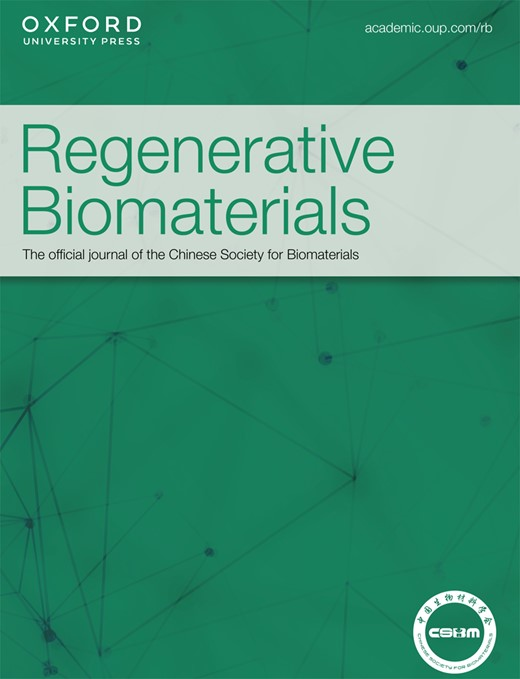三维生物打印在再生医学应用方面的进展
IF 5.6
1区 医学
Q1 MATERIALS SCIENCE, BIOMATERIALS
引用次数: 0
摘要
生物制造技术可利用生物材料、细胞和生物分子构建生物相容性和生物功能结构。生物打印是一种新兴的 3D 打印方法,它利用基于生物材料的混合物与细胞和其他生物成分制成可打印的悬浮液(称为生物墨水)。三维生物打印机与自动设计方案相结合,基于不同的液滴沉积模式,能够制造出具有特定结构和几何特性的水凝胶物体,提供必要的环境,促进细胞生长并引导细胞分化为与应用相关的细胞系。为了制备这种生物墨水,人们采用了各种水溶性生物材料,包括天然和合成生物聚合物以及无机材料。生物打印构建体因其模仿原生器官的生物特性而被认为是再生医学中最有前途的途径之一。要想成功应用,生物打印构建体应满足特定的标准,如最佳的生物反应、与目标组织相似的机械性能、高水平的可重复性和打印保真度,以及更强的放大能力。在这篇综述中,我们将重点介绍生物打印技术的最新进展,关注各种组织的再生,包括骨、软骨、心血管、神经、皮肤以及肝、肾、胰腺和肺等其他器官。我们讨论了快速发展的共培养生物打印系统,该系统用于模拟组织和器官的复杂性,以及不同细胞群之间为实现再生而产生的相互影响。此外,我们还报告了三维生物打印的基本物理原理,以及基于生物材料再生潜力的理想生物墨水特性。我们研究并批判性地讨论了三维生物打印在其适用性方面的现状以及当前需要克服的局限性,以便将其确立为人工器官生产和移植的前沿技术。本文章由计算机程序翻译,如有差异,请以英文原文为准。
Advances in 3D bioprinting for regenerative medicine applications
Biofabrication techniques allow for the construction of biocompatible and biofunctional structures composed from biomaterials, cells and biomolecules. Bioprinting is an emerging 3D printing method which utilizes biomaterial-based mixtures with cells and other biological constituents into printable suspensions known as bioinks. Coupled with automated design protocols and based on different modes for droplet deposition, 3D bioprinters are able to fabricate hydrogel-based objects with specific architecture and geometrical properties, providing the necessary environment that promotes cell growth and directs cell differentiation towards application-related lineages. For the preparation of such bioinks, various water-soluble biomaterials have been employed, including natural and synthetic biopolymers, and inorganic materials. Bioprinted constructs are considered to be one of the most promising avenues in regenerative medicine due to their native organ biomimicry. For successful application, the bioprinted constructs should meet particular criteria such as optimal biological response, mechanical properties similar to the target tissue, high levels of reproducibility and printing fidelity, but also increased upscaling capability. In this review, we highlight the most recent advances in bioprinting, focusing on the regeneration of various tissues including bone, cartilage, cardiovascular, neural, skin, and other organs such as liver, kidney, pancreas, and lungs. We discuss the rapidly developing co-culture bioprinting systems used to resemble the complexity of tissues and organs and the crosstalk between various cell populations towards regeneration. Moreover, we report on the basic physical principles governing 3D bioprinting, and the ideal bioink properties based on the biomaterials’ regenerative potential. We examine and critically discuss the present status of 3D bioprinting regarding its applicability and current limitations that need to be overcome to establish it at the forefront of artificial organ production and transplantation.
求助全文
通过发布文献求助,成功后即可免费获取论文全文。
去求助
来源期刊

Regenerative Biomaterials
Materials Science-Biomaterials
CiteScore
7.90
自引率
16.40%
发文量
92
审稿时长
10 weeks
期刊介绍:
Regenerative Biomaterials is an international, interdisciplinary, peer-reviewed journal publishing the latest advances in biomaterials and regenerative medicine. The journal provides a forum for the publication of original research papers, reviews, clinical case reports, and commentaries on the topics relevant to the development of advanced regenerative biomaterials concerning novel regenerative technologies and therapeutic approaches for the regeneration and repair of damaged tissues and organs. The interactions of biomaterials with cells and tissue, especially with stem cells, will be of particular focus.
 求助内容:
求助内容: 应助结果提醒方式:
应助结果提醒方式:


